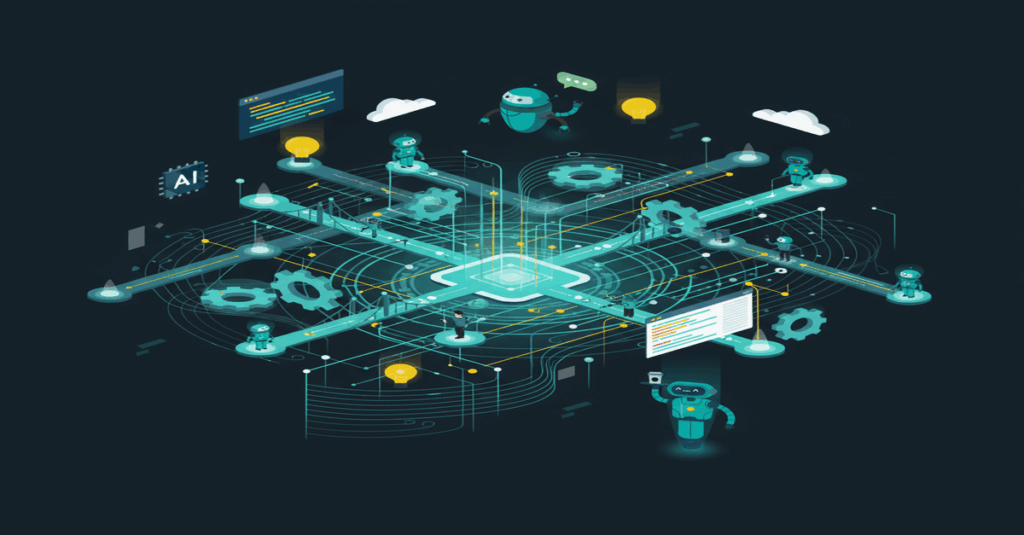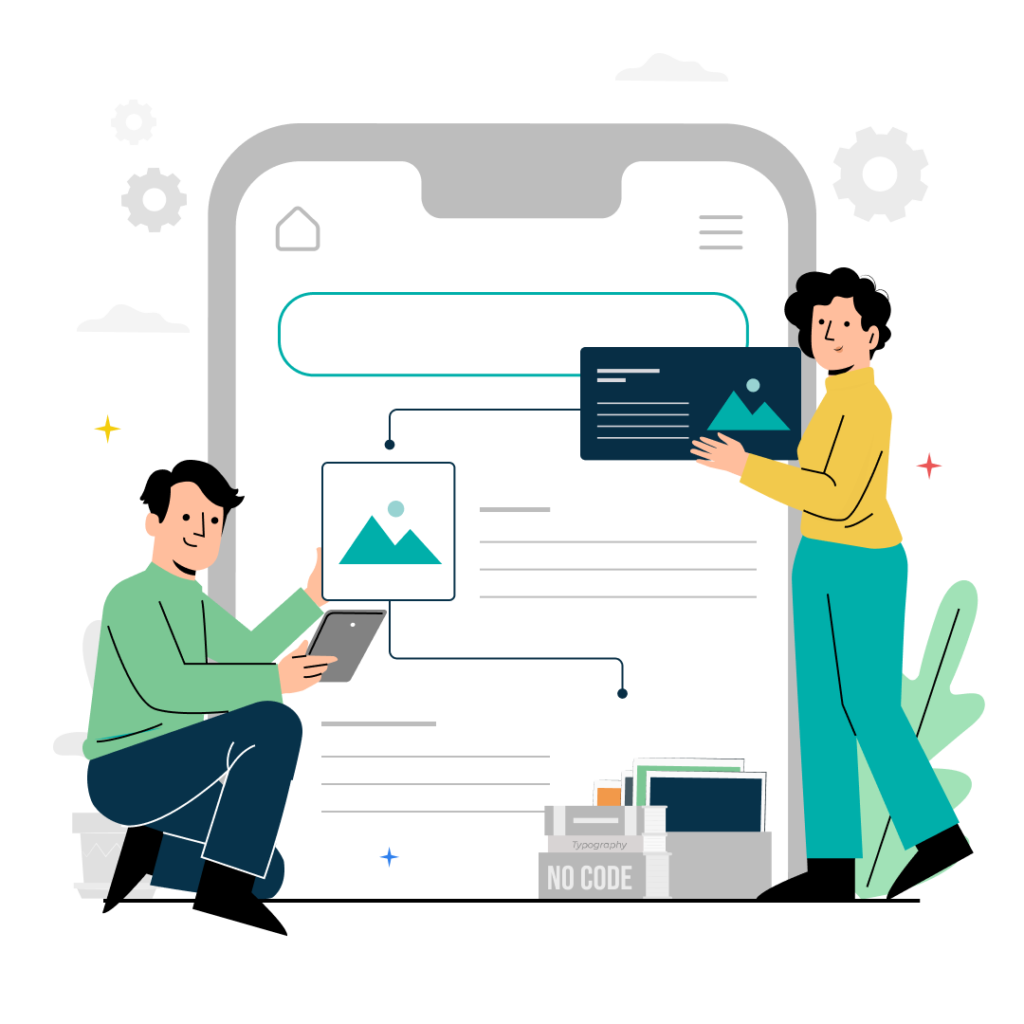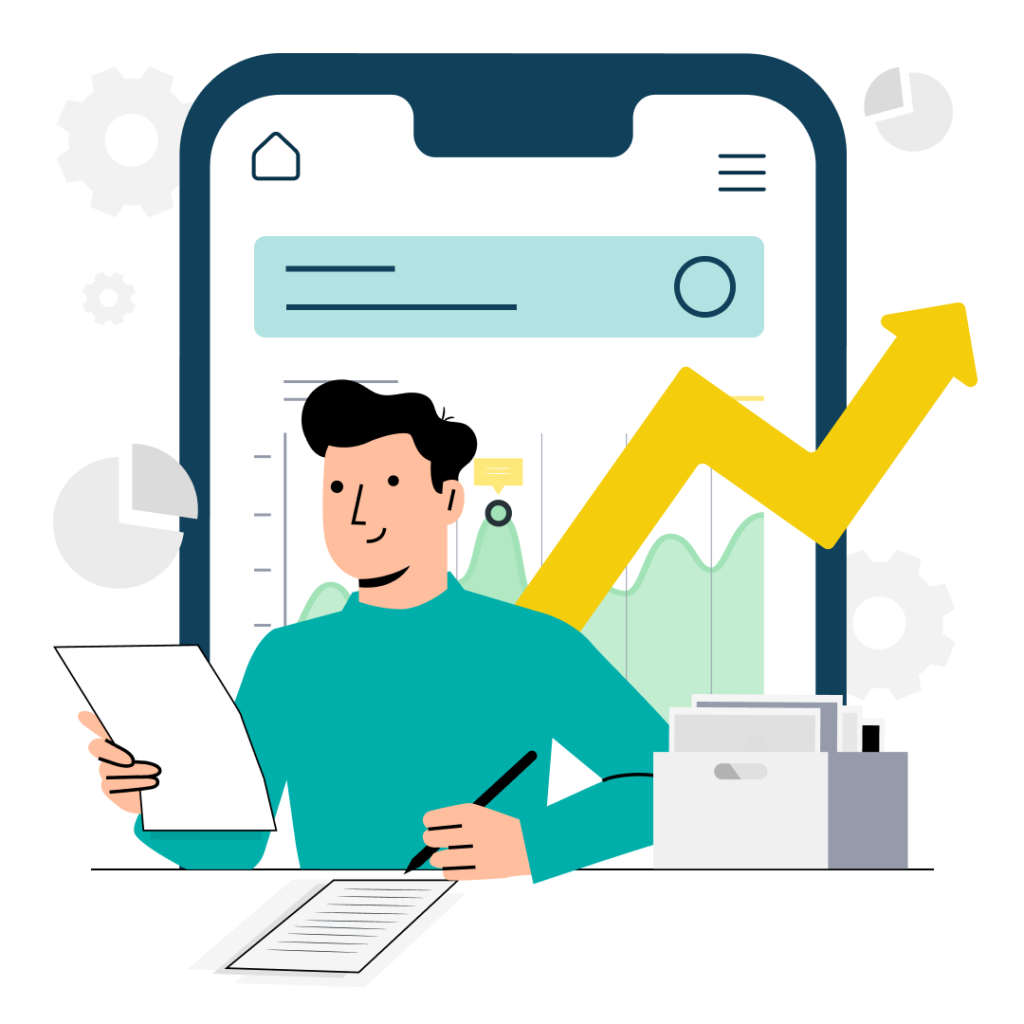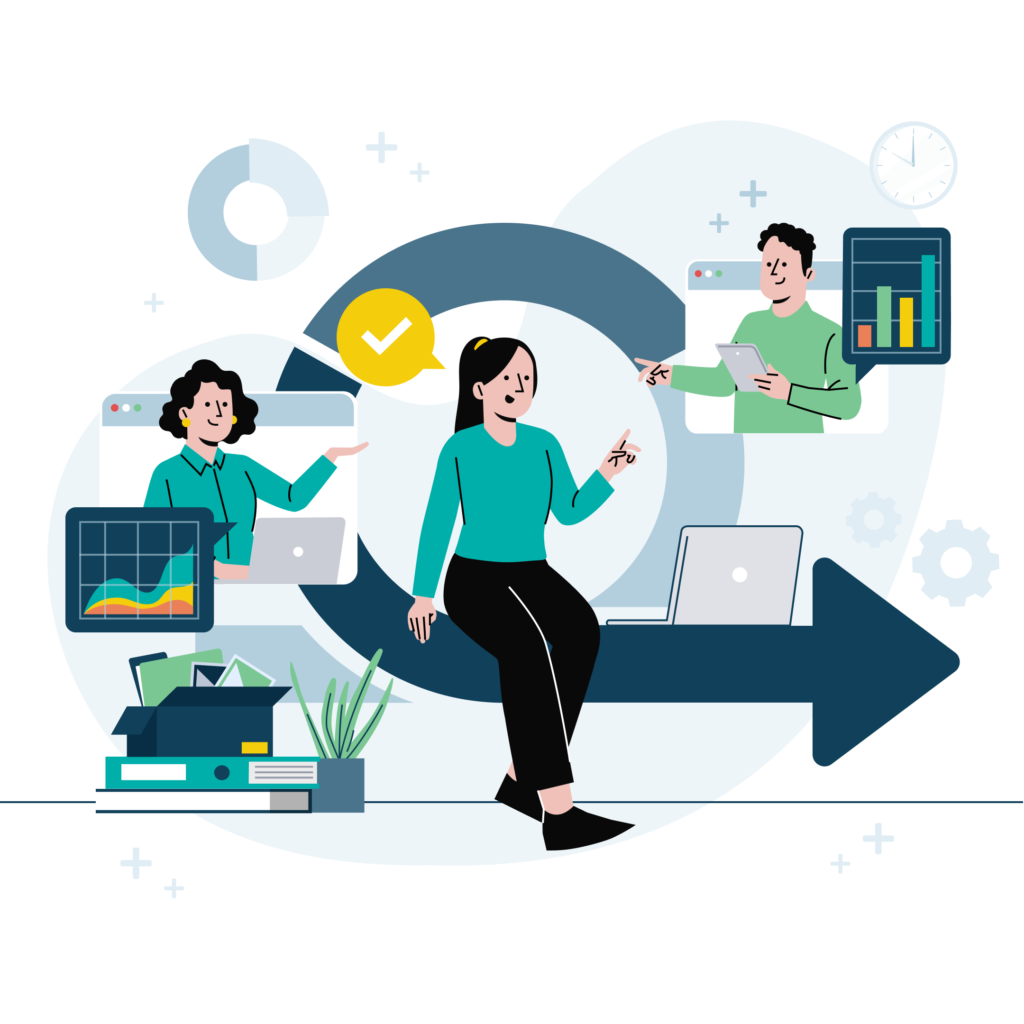Pillar Page: Understanding AI Agents and Autonomous Systems
Target Length: 1,400 words (optimised for web engagement) Focus: Comprehensive overview and decision support for AI agents topic Audience: New CTOs with developer background, ages 32-42 Cluster Articles: 7 deep-dive articles covering fundamentals, architecture, applications, security, platforms, implementation, and ROI Publication Date: November 2025
Overview
This pillar page serves as a navigation hub for understanding AI agents and autonomous systems. Rather than providing a comprehensive guide, it offers high-level introductions to key concepts with strategic signposting to seven in-depth cluster articles. The page addresses eight fundamental questions that readers typically ask when encountering AI agents for the first time, providing enough context to understand what each topic covers before directing readers to detailed content.
Hero Section (150–200 words)
What You’ll Learn in This Guide
AI agents represent a fundamental shift from traditional chatbots and automation tools to systems that can autonomously pursue goals, make decisions, and take action with minimal human intervention. This isn’t just incremental improvement—it’s a paradigm change that’s reshaping how software operates across industries, from security research to e-commerce.
This guide provides you with the essential framework for understanding AI agents: what distinguishes genuine autonomy from sophisticated automation, why multiple agents working together matter, and how to evaluate whether agents make sense for your organisation. You’ll find practical guidance on security considerations, platform selection, implementation approaches, and measuring success—all informed by major announcements from October 2025 including GitHub Agent HQ, OpenAI Aardvark, and PayPal’s agentic commerce integration.
Whether you’re evaluating AI agents for the first time or planning implementation, this hub connects you to the specific deep-dive content you need. Start with fundamentals if you’re new to agents, jump to security if you’re concerned about autonomous systems accessing your code, or explore platforms if you’re ready to select a vendor.
What Are AI Agents and How Do They Differ from Chatbots?
Direct Answer:
AI agents are autonomous software systems that use artificial intelligence to pursue goals and complete tasks with minimal human intervention, fundamentally different from chatbots which respond reactively to user queries. Agents can make independent decisions, use external tools and APIs, reason about complex problems, and take action without waiting for user input. This autonomy—combined with the ability to understand context, adapt behaviour, and work toward defined objectives—distinguishes agents from traditional chatbots and RPA systems that follow predefined rules or patterns.
Key Considerations:
- Autonomy vs Reactivity: Chatbots wait for user input then generate responses. Agents set goals, plan actions, and execute them independently.
- Tool Use: Agents can invoke APIs, databases, and external systems. Chatbots generate text only.
- Reasoning: Agents evaluate options, weigh trade-offs, and adapt decisions based on outcomes. Chatbots follow conversation patterns.
Learn More: Explore the foundational concepts in our AI Agent Fundamentals and Distinguishing Real Autonomy from Agent Washing guide, which includes frameworks for detecting agent washing and evaluating vendor claims. This foundational resource answers definitional questions before exploring advanced agent architectures.
Why Do Multi-Agent Systems Matter?
Direct Answer:
A single agent can handle well-defined tasks, but complex problems often exceed what one agent can accomplish. Multi-agent systems enable specialisation (agents focused on specific domains), parallel processing (agents working on subtasks simultaneously), and emergent capabilities (agents collaborating to solve problems neither could handle alone). This is why GitHub announced Agent HQ in October 2025—positioning orchestration as the “mission control” layer that coordinates competing or complementary agents across complex software development workflows.
Key Considerations:
- When Single Agents Suffice: Narrow, well-scoped tasks with clear input-output relationships.
- When Multi-Agent Matters: Complex problems requiring specialised subtasks, high volume processing, or adaptive coordination.
- Orchestration Critical: Multiple agents need a coordination layer to manage task assignment, communication, result aggregation, and conflict resolution.
Learn More: Discover how orchestrating multiple agents enables enterprise-scale autonomous systems with architectural patterns and integration guidance. Our deep-dive into multi-agent coordination explains GitHub Agent HQ’s architecture and when orchestration becomes essential.
Where Are AI Agents Being Used Successfully?
Direct Answer:
AI agents are moving from research to production across three emerging categories: autonomous security research (OpenAI Aardvark for continuous vulnerability discovery), agentic commerce (PayPal’s 434M-account integration enabling autonomous shopping), and AI-powered coding (agents like Cursor and Cognition SWE-1.5 handling code generation and testing). October 2025 announcements from all three domains signal market maturity. Real deployments show success rates varying dramatically by use case—from 23% in B2B sales to 94% in data-quality-dependent applications—indicating that implementation quality and scoping matter more than the technology itself.
Key Considerations:
- Security Applications: Background agents running 24/7 discovering vulnerabilities autonomously.
- Commerce Applications: Autonomous purchasing agents transforming e-commerce from chatbot assistance to independent decision-making.
- Coding Applications: Agents handling code generation, testing, and debugging at production scale.
- Success Varies: Use case, data quality, and proper scoping determine outcomes more than platform choice.
Learn More: Explore agentic commerce and emerging applications for detailed case studies and market leader analysis. Our comprehensive guide to AI agent applications transforming industries includes vertical use case matrices and PayPal integration analysis.
How Do You Deploy AI Agents Securely?
Direct Answer:
Autonomous agents accessing your code, data, or systems introduce real security challenges, but they’re manageable through frameworks specifically designed for agentic systems. Non-Human Identity (NHI) frameworks provide authentication and authorisation for autonomous agents. Continuous monitoring detects anomalous agent behaviour. Threat modelling specific to autonomous systems (prompt injection, goal hijacking, privilege escalation) identifies risks. Practical checklists covering pre-deployment validation, runtime controls, and incident response transform theoretical security into operational practice.
Key Considerations:
- Real Risks Exist: Autonomous agents can be manipulated or misconfigured, introducing genuine security concerns.
- Risks Are Manageable: NHI frameworks, monitoring, and threat modelling provide effective mitigation.
- Security Enables Opportunity: OpenAI Aardvark demonstrates security agents performing better than human security researchers—the same technology that poses risks enables transformative capabilities.
Learn More: Deep-dive into agentic security frameworks for NHI implementation guidance. Our detailed guide on deploying AI agents securely includes security deployment checklists and threat models, with specific reference to OpenAI Aardvark’s approach to autonomous security research.
Which AI Agent Platform Should You Choose?
Direct Answer:
The agent platform landscape includes enterprise orchestration platforms (GitHub Agent HQ, IBM Watsonx), open-source frameworks (n8n, Flowise), and cloud infrastructure (Azure AI, AWS Bedrock, Google Cloud Vertex AI). No single “best” platform exists—the right choice depends on your autonomy requirements, integration needs, team skill level, and risk tolerance for vendor lock-in. Evaluation frameworks focused on objective criteria (rather than marketing claims) help distinguish genuine agent orchestration from rebranded automation tools.
Key Considerations:
- Enterprise vs Open-Source: Enterprise platforms offer support and integration. Open-source provides control and flexibility.
- Integration Ecosystem: Some platforms integrate easily with existing infrastructure; others require substantial refactoring.
- Vendor Lock-In: Evaluate exit strategies and data portability before committing to platforms.
- Total Cost of Ownership: Development, licensing, infrastructure, and ongoing maintenance vary significantly.
Learn More: Consult our comprehensive platform selection guide for vendor comparison matrices and evaluation frameworks. Our deep-dive into evaluating agent orchestration tools provides build vs buy analysis and assessment criteria for open-source versus enterprise platforms.
How Do You Implement AI Agents in Production?
Direct Answer:
Enterprise agent implementation follows a structured roadmap: design your agent system architecture, select and validate your platform, develop and test agents in isolated environments, execute staged rollouts (dev → staging → production), monitor performance and behaviour, and establish incident response procedures. Production reliability requires patterns like health checks, circuit breakers, graceful degradation, and comprehensive observability. The critical insight is that agents can operate 24/7 safely when deployed with proper controls, monitoring, and runbook procedures—not because they’re inherently stable, but because you’ve designed for failure and recovery.
Key Considerations:
- Staged Rollout Essential: Don’t deploy agents directly to production without validation in lower environments.
- Monitoring Mandatory: Continuous monitoring detects anomalies before they become failures.
- Runbooks Required: Documented incident response procedures prevent firefighting.
- Reliability Patterns: Circuit breakers, health checks, and graceful degradation make 24/7 operation feasible.
Learn More: Follow our enterprise implementation guide for step-by-step deployment checklists and operational patterns. Our comprehensive resource on deploying agent systems safely covers implementation roadmaps, GitHub Agent HQ integration specifics, and reliability patterns for 24/7 operation.
How Do You Measure ROI from AI Agents?
Direct Answer:
80% of AI projects fail, but some achieve 94% success rates—the difference lies in clear goal-setting, data quality, proper scoping, and realistic timeline expectations. ROI measurement frameworks quantify impact through specific metrics: task completion rate improvements, time savings (developer productivity or support deflection), error reduction (quality improvements), cost per transaction (efficiency), and revenue impact (conversion rates or basket size). Success requires treating agents as business experiments with explicit hypotheses, success criteria, and iteration loops—not technology implementations.
Key Considerations:
- Failure Rate Context: 80% failure reflects unclear goals and poor scoping, not technology limitations. Proper methodology improves to 94% success.
- Quantifiable Metrics: Focus on measurable outcomes (time saved, errors prevented, revenue generated) rather than technology features.
- Iterative Approach: Start narrow, validate assumptions, then expand rather than attempting comprehensive deployments.
- Data Quality Critical: Agent success depends entirely on input data quality—garbage in produces garbage out.
Learn More: Understand ROI measurement frameworks for quantifying agent implementation value. Our detailed resource on preventing AI agent failure includes business case templates, failure prevention checklists, and real-world success case analysis comparing 23%, 65%, and 94% success rates.
What Are the Latest AI Agent Announcements?
Direct Answer:
October 2025 saw three major announcements signalling market maturity: GitHub Agent HQ (October 28) positioning multi-agent orchestration for software development, PayPal’s integration with OpenAI (October 28) launching agentic commerce at scale with 434M accounts, and OpenAI Aardvark (October 30) demonstrating GPT-5 powered autonomous security research. These announcements aren’t isolated product launches—they represent major vendors committing resources to agent infrastructure, demonstrating that autonomous systems are moving from research to enterprise adoption.
Key Considerations:
- Timing Matters: News hooks from major vendors create validation and urgency for agent adoption.
- Each Targets Different Needs: Orchestration (GitHub), commerce applications (PayPal), security (Aardvark) address distinct business problems.
- Vendor Commitment Signals Maturity: Major players investing in agent infrastructure suggests sustainable market, not hype cycle.
Learn More: Explore specific announcements in our detailed articles: GitHub Agent HQ and multi-agent orchestration, PayPal agentic commerce and emerging applications, and OpenAI Aardvark security frameworks.
Resource Hub: AI Agents and Autonomous Systems Library
Foundational Understanding
- AI Agent Fundamentals and Distinguishing Real Autonomy from Agent Washing: Clear definitions, autonomy criteria, detection framework for agent washing, and guidance for evaluating vendor claims
- Multi-Agent Orchestration and How GitHub Agent HQ Coordinates Autonomous Systems: Architecture patterns, GitHub Agent HQ deep-dive, decision frameworks for single vs multi-agent approaches
Application and Market Landscape
- Agentic Commerce and Emerging AI Agent Applications Transforming Industries: PayPal case study, market leader landscape, agent type taxonomy, vertical use case analysis across e-commerce, coding, customer service, and sales automation
Security and Governance
- OpenAI Aardvark and Deploying AI Agents Securely with Agentic Security Frameworks: Aardvark technical breakdown, NHI frameworks, deployment security checklists, continuous monitoring patterns, threat modelling for agentic systems
Evaluation and Selection
- Platform Selection and Evaluating AI Agent Orchestration Tools for Enterprise Development: Vendor-neutral platform comparison (7+ platforms), evaluation frameworks, build vs buy analysis, open-source options, vendor lock-in assessment
Implementation and Operations
- Enterprise Implementation and Deploying AI Agent Systems in Production Safely: Implementation roadmap, deployment checklists, GitHub Agent HQ integration guide, 24/7 reliability patterns, monitoring and observability configuration, incident response procedures
Business Value and Success
- ROI Measurement and Preventing the Eighty Percent AI Agent Failure Rate: Failure rate analysis and prevention, ROI calculation frameworks, success case comparison, GPT-5 vs GPT-4 technical comparison, business case templates, KPI dashboards
FAQ: Common Questions About AI Agents
What Is Agent Washing and How Do I Detect It?
Agent washing refers to marketing traditional automation tools, chatbots, or RPA systems as “AI agents” without genuine autonomous capabilities. Detection requires evaluating autonomy criteria: Does the system set goals independently? Make decisions without explicit rules? Use external tools adaptively? Learn from outcomes? Genuine agents demonstrate these capabilities; agent washing relies on marketing language without substance. Our AI Agent Fundamentals guide provides a detection checklist for evaluating vendor claims.
Can I Start with a Single Agent and Add Multi-Agent Orchestration Later?
Yes. Single agents suit narrow, well-scoped problems. As complexity grows—multiple specialised tasks, high volume, or adaptive coordination—orchestration becomes necessary. The approach is pragmatic: design modularly from the start, but don’t over-engineer for scale you don’t yet have. Our orchestration decision framework explores this progression in detail, while our implementation guide shows how to evolve your architecture safely.
How Long Until We See ROI from AI Agents?
Timeline depends on use case scoping and implementation quality. Narrow, well-scoped implementations often show results within 2-3 months. Broader deployments typically require 6+ months. The critical success factor is starting with measurable hypotheses, iterating based on data, and expanding gradually. Our ROI measurement guide provides realistic timelines for different implementation types, while enterprise implementation planning helps you structure deployments for faster value realisation.
Are AI Agents Really Autonomous or Just Sophisticated Automation?
Both perspectives contain truth. Agents are more autonomous than traditional automation—they make independent decisions, adapt behaviour, and pursue goals. They’re less autonomous than humans—operating within defined parameters and guardrails. The spectrum from rule-based RPA to truly autonomous agents is continuous. Evaluation requires examining specific capabilities rather than accepting marketing claims. Our agent fundamentals guide addresses this directly with technical criteria, while our security frameworks article explains how to design guardrails for autonomous operation.
What Security Risks Exist When Deploying AI Agents?
Real risks include prompt injection (manipulating agent instructions), goal hijacking (redirecting agent objectives), privilege escalation (agents exceeding intended permissions), and data exposure (agents accessing unintended systems). These risks are manageable through NHI frameworks, monitoring, and threat modelling. Our agentic security framework guide provides implementation guidance for each risk category, complemented by production deployment security practices that integrate security into your implementation roadmap.
Should I Build Custom Agents or Use a Platform?
The decision depends on unique requirements, timeline, team skills, and total cost of ownership. Platforms offer faster time-to-value and vendor support. Custom development provides maximum control but requires more resources. Hybrid approaches (open-source frameworks + custom development) balance both needs. Our platform evaluation guide provides a cost-benefit framework for this build-or-buy decision, with implementation guidance available in our production deployment guide.
How Do I Evaluate Whether AI Agents Fit My Use Case?
Ask three questions: (1) Does the problem require autonomous decision-making or can rules/automation handle it? (2) Will the value justify development and operational costs? (3) Are you committed to iterative improvement or expecting agents to work perfectly immediately? If all three get positive answers, agents likely fit. If not, traditional automation may be more appropriate. Our platform selection guide covers vendor-neutral evaluation criteria, while our ROI measurement frameworks help you quantify expected value and validate your business case.
What’s the Difference Between GPT-5 Agents and GPT-4 Agents?
GPT-5 demonstrates enhanced reasoning capabilities making it better suited for complex autonomous decisions. For agent applications, this means improved reliability (fewer hallucinations), better code understanding (relevant for coding agents), and superior threat modelling (relevant for security agents). The difference is meaningful for complex agents but marginal for narrow, well-scoped applications. Our ROI measurement guide compares these models in detail, while our security frameworks article demonstrates GPT-5’s threat modelling capabilities with OpenAI Aardvark.
Next Steps: Where to Start
New to AI Agents? Start with AI agent fundamentals for clear definitions and an agent washing detection framework. This foundational guide establishes definitions before exploring advanced topics.
Exploring Advanced Architecture? Jump to multi-agent orchestration and GitHub Agent HQ to understand how enterprises coordinate multiple autonomous systems at scale.
Evaluating Autonomous Systems for Your Organisation? Jump to platform selection if ready to compare vendors using objective evaluation criteria, or ROI measurement frameworks to build a business case for leadership approval.
Concerned About Security Risks? Explore agentic security frameworks and NHI implementation guidance before proceeding with deployments involving autonomous system access.
Ready to Implement? Follow enterprise implementation guidance for step-by-step deployment roadmaps including GitHub Agent HQ integration and production reliability patterns.
Interested in Business Applications? Review agentic commerce and emerging applications to see where agents are creating competitive advantage across industries.
Conclusion
AI agents represent genuine technological advancement, not marketing hype. The October 2025 announcements from GitHub, PayPal, and OpenAI demonstrate that agents are moving from research projects to enterprise systems. The key insight isn’t whether agents are valuable—they demonstrably are—but rather understanding where they provide genuine advantage over traditional automation and implementing them with proper attention to design, security, operations, and measurement.
This guide connects you to seven comprehensive deep-dives: AI agent fundamentals for definitional clarity, multi-agent orchestration for enterprise architecture, emerging applications for market validation, agentic security frameworks for safe deployment, platform selection for vendor evaluation, enterprise implementation for operational guidance, and ROI measurement for business justification. Each article stands alone while connecting to the others through a coherent framework.
Your next step depends on your current stage: understanding concepts, evaluating platforms, building business cases, or preparing for production deployment. Begin where it makes sense for your current needs. Return to this hub whenever you need to navigate to a specific topic. And recognise that AI agent adoption isn’t a single decision—it’s an iterative journey from awareness through experimentation to operational deployment.












